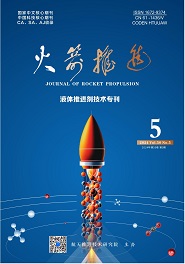航天推进技术研究院主办
LI Qiang,LI Jiawen,WANG Ge,et al.Research on thermodynamic performance of a new aerospace nuclear thermal propulsion system[J].Journal of Rocket Propulsion,2018,44(06):21-28.
新型空间双模式核热推进系统热力学性能研究
- Title:
- Research on thermodynamic performance of a new aerospace nuclear thermal propulsion system
- 文章编号:
- 1672-9374(2018)06-0021-08
- 分类号:
- V439+.5-34
- 文献标志码:
- A
- 摘要:
- 基于再膨胀布雷顿回热循环,提出了一种新型空间双模式核热推进系统方案。针对使用氦作为工质的情况,对该推进系统发电模式下的性能进行了分析计算,获得了循环增温比和增压比以及再膨胀分配系数对发电模式循环性能的影响规律。结果表明:在同样设计参数下,此循环效率高于基本布雷顿回热循环,散热器面积小于基本布雷顿回热循环。循环增温比的增加会提高此循环效率,增压比的增加则会降低循环效率。对再膨胀分配系数的分析计算表明,在循环增压比分别为3和6的条件下,循环效率在膨胀分级比为0.83和1.05左右达到最大值。随着循环增压比的增大,循环输出功率最大值对应的分配系数也逐渐从左极值向右移动。此循环作为空间核热推进系统发电模式的循环方案,可以有效减小航天器的体积和重量。
- Abstract:
- In this paper, a new aerospace nuclear thermal propulsion system scheme is proposed on the basis of re-expand regenerative Brayton cycle.The system performance in power generation mode was simulated and analyzed while helium was used as the working medium.The influence of cycle temperature ratio, pressure ratio and reexpansion distribution coefficient of turbine on the power generation cycle performance were achieved.The results indicate that, with the same design parameters, the efficiency of this cycle is higher than that of regenerative cycle based on Brayton, but its radiator area is less than regenerative cycle based on Brayton.Cycle efficiency increases with the increase of cycle temperature ratio, but decreases with the increase of pressure ratio.The cycle efficiency reached the maximum value while pressure ratio distribution coefficient of turbine is at about 0.83 and 1.05 under the conditions of cycle pressure ratio at 3 and 6.With the increase of the cycle pressure ratio, the distribution coefficient corresponding to maximum value of the cycle output power moves to right from left extreme value.This cycle, when used as scheme for power generation mode of space nuclear thermal propulsion,can effectively reduce the size and weight of the spacecraft.
参考文献/References:
[1] 张郁.电推进技术的研究应用现状及其发展趋势[J].火箭推进, 2005, 31(2):27-36.
ZHANG Y.Gurrent status and trend of electric propulsion technology development and application[J].Journal of rocket propulsion, 2005,31(2):27-36.
[2] 廖宏图.核热推进技术综述[J].火箭推进, 2011, 37(4):1-11.
LIAO H T.Overiew of nuclear termal propulsion technologies[J].Journal of rocket propulsion,2011,37(4):1-11.
[3] 熊延龄.美载人月球/火星探测核动力火箭方案[J].国际太空, 1992(5):20-21.
[4] 戴进池.俄罗斯空间核动力技术的发展[J].国防科技, 2001(17):10-11.
[5] BUDEN D, KENNEDY F, JACOX M.Bimodal nuclear power and propulsion-Scoping the design approaches[C]// Space Programs and Technologies Conference.USA:[s.n.], 2006.
[6] WILLOUGHBY A, BOROWSKI S.The leverage of "bimodal" nuclear thermal rockets in planetary protection[C]// Planetary Defense Conference: Protecting Earth From Asteroids.[s.l.]:[s.n.],2013.
[7] WILSON M, WILHITE A, KOMAR D R.Bimodal nuclear thermal rocket propulsion systems for human exploration of mars[C]// AIAA/ASME/SAE/ASEE Joint Propulsion Conference & Exhibit.USA:[s.n.] 2013.
[8] AIAA.Integrated propulsion and power modeling for bimodal nuclear thermal rockets[C]//AIAA/ASME/SAE/ASEE Joint Propulsion Conference & Exhibit.USA:[s.n.], 2007.
[9] NAM S H, VENNERI P, KIMi Y, et al.Innovative concept for an ultra-small nuclear thermal rocket utilizing a new moderated reactor[J].Nuclear engineering & technology, 2015, 47(6):678-699.
[10] GOODARZI M.Comparative energy analysis on a new regenerative Brayton cycle[J].Energy conversion & management, 2016, 120:25-31.
[11] TOURNIER J M, ELGENK M, GALLO B.Best estimates of binary gas mixtures properties for closed Brayton cycle space applications[C]// International Energy Conversion Engineering Conference and Exhibit.[s.l.]:[s.n.],2006.
[12] RIBEIRO G B, FILHO F B.Thermodynamic analysis and optimization of a closed Regenerative Brayton cycle for nuclear space power systems[J].Applied thermal engineering, 2015, 90:250-257.
[13] 冯致远, 张昊春, 吉宇,等.航天器核动力推进系统热力学性能研究[J].载人航天, 2016, 22(6):797-804.
[14] SADATSAKKAK S A, AHMADI M H, AHMADI M A.Thermodynamic and thermo-economic analysis and optimization of an irreversible regenerative closed Brayton cycle[J].Energy conversion & management, 2015, 94:124-129.
[15] 朱森元.氢氧火箭发动机及其低温技术[M].北京:中国宇航出版社, 2016.
备注/Memo
收稿日期:2017-11-24; 修回日期:2018-01-23 基金项目:载人航天第三批预先研究项目(1664050201) 作者简介: 李 强(1993—),男,硕士,研究领域为新概念推进系统
